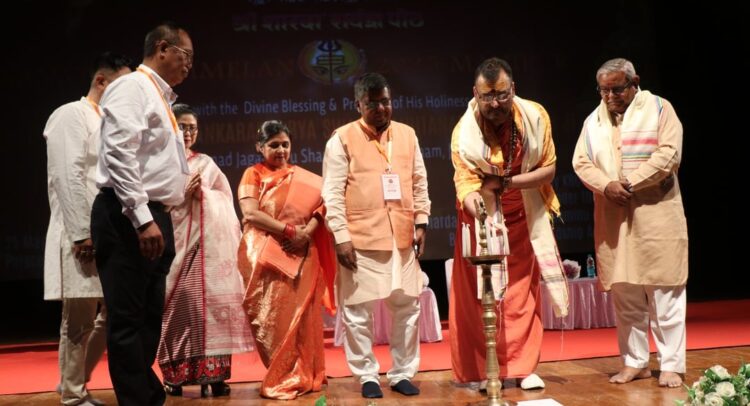Imphal (Waari Singbul Network) : On a day of rare stillness in strife-torn Manipur, a sacred whisper stirred the heart of Imphal. At the Palace Auditorium of the Manipur State Film Development Society, an assembly not merely of people but of prayers and purpose took place. The first-ever Sanatan Sammelan in Manipur—under the profound theme Peace, Progress and Prosperity—gathered together the faithful in a moment that may well mark a spiritual turning point for this ancient land.
This was not a political rally, nor a mere conference. It was a congregation of soul and soil—a return to roots for a people long shaken by the tremors of division, conflict, and forgetfulness. Organised by the KRC Foundation in association with Shrimad Jagadguru Sharda Sarvagya Pitham of Jammu & Kashmir and the Barak-Manipur Friendship Association, this Sammelan shone like a lamp in the dusk of civil uncertainty. And that lamp was lit by the divine presence of His Holiness Jagadguru Shankaracharya Swami Amritananda Devtirth Ji Maharaj, spiritual head of the Pitham, whose arrival in the northeast came like the arrival of a long-awaited rain on parched earth.
Manipur: Where Dharma Finds a Home
It is no accident that this Sanatan Sammelan was held here, in this border state—a land that once witnessed Netaji Subhas Chandra Bose’s Azad Hind Fauj hoisting the tricolour for the first time on Indian soil, as recalled with solemn pride by his great grandniece, Smt. Rajyashree Chaudhuri. In her stirring speech, she reminded the gathering that Manipur is not peripheral to Bharat—it is Bharat. From the Mahabharata’s mention of Chitrangada, consort of Arjuna, to its resilient Vaishnavite and Sanamahi traditions, Manipur has never ceased to be a sacred frontier of Dharma.
It is this spiritual and civilizational memory that the Sammelan sought to reignite. And it did so not through fiery slogans but through the quiet force of truth, tradition, and testimony.
Sanatana Dharma and Sanamahi Tradition: A Sacred Kinship
His Holiness, the Shankaracharya, began with a Vedic invocation that calmed the hall like a mantra over troubled waters. He did not speak in abstractions but in recognition. “Manipur is in trouble,” he said plainly, “and the country stands with you.” A son of Kashmir—another borderland wounded by violence—he knows what it means for a place of beauty and spirit to be turned into a battleground.
Yet he saw more than sorrow in Manipur. He saw strength. He praised the enduring spiritual life of the Meitei people, acknowledging the deep kinship between Sanatan Dharma and Sanamahi beliefs. Both, he said, are rooted in the worship of nature, of ancestors, of the eternal cycle of life. Where Sanatan Dharma venerates the elements through Surya (sun), Agni (fire), Vayu (wind), Jal (water), and Devi (Shakti), Sanamahism celebrates life through Lai Haraoba, the dance of the gods. These are not two systems but twin streams of one ancient river.
And in a world that increasingly forgets the sacred, such memory is not a luxury—it is survival.
The Call to Preserve and Protect
The Sammelan was also a call to action. Shri Bajran Lal Bagra, General Secretary of the Vishva Hindu Parishad, issued a blunt warning: that the demography of Sanatana Dharma is under threat, not just in Manipur but across the nation. “Our numbers are dwindling,” he said, “and if we do not rise with wisdom and resolve, we risk becoming strangers in our own homeland.”
This is not mere alarmism. In Manipur, where the valley remains predominantly Hindu and the hills largely Christian, the lines of faith and conflict are not easily separated. The call was not for antagonism, but for awareness. For vigilance without violence. For a revival not just of population but of purpose.
A Sacred Mission Beyond Ritual
The spiritual significance of the Sammelan was amplified by the Shankaracharya’s continuing itinerary. His visit to the Shree Govindaji Temple, his role in inaugurating the Shrimad Jagadguru Sharda Sarvagya Pitham’s Pranth office in Thangmeiband, and his planned interaction with displaced persons in relief camps speak of a spirituality that does not rest in temple walls but walks among the wounded. This is Dharma in motion—not just puja, but protection. Not just worship, but welfare.
And as the sun set on the Sammelan, a think tank of intellectuals and spiritual minds gathered to discuss The Idea of Manipur—past, present, and future. The quiet urgency of that dialogue cannot be overstated. In a land where the sacred and the secular, the hill and the valley, the ancient and the immediate are in constant tension, such dialogue is not optional—it is essential.
A Flame Rekindled
In hosting the first Sanatan Sammelan, Manipur has done something both symbolic and substantial. It has proclaimed, not in aggression but in grace, that it still remembers its soul. That it refuses to be defined only by its wounds. That despite the fire and ash of recent years, the eternal flame of Dharma still flickers, still glows.
“In the time to come, more will be needed—more gatherings, more unity, more courage. But for now, this flame is enough. It is a beginning. A prayer turned into presence. A signal to the rest of Bharat that the eastern gate of Dharma is still guarded”, said Biswadeep Gupta the architect of this spiritual gathering.
For in the words of His Holiness: “A country that prioritizes religion attains greatness. Those that do not, wither away.” May Manipur, the last Hindu bastion of the Northeast, not merely survive, but lead the way.
***


